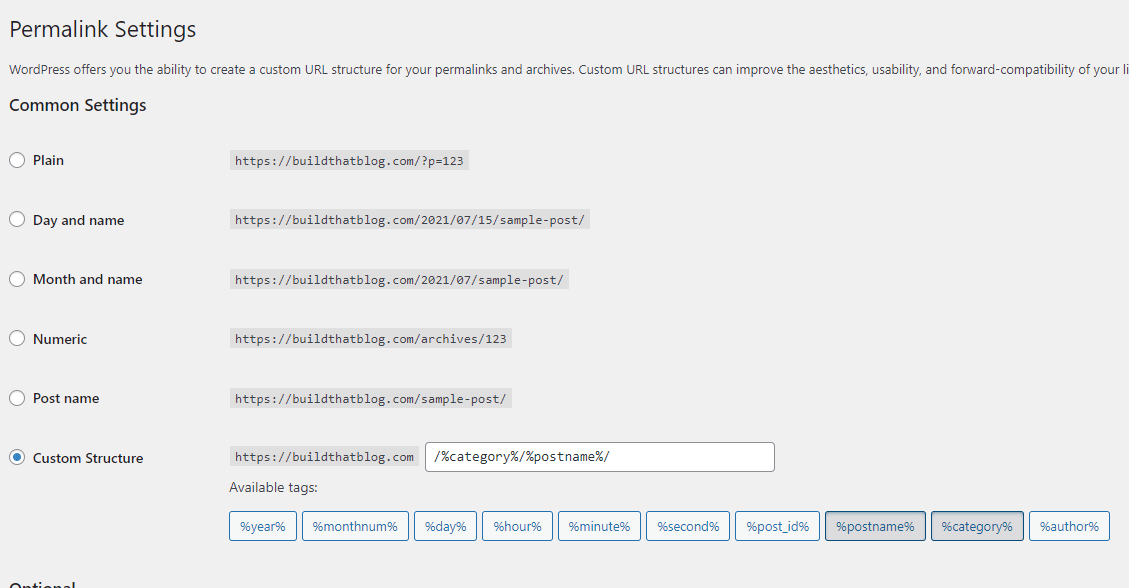Thanks for telling us that you've set up your blog, but you need to work on developing it and adding content 🙂
The ultimate goal is, of course, to start generating an income from your blog, but you can't do that until you start marketing it, and there's no point in marketing it if it's not ready.
BUT, not being ready does not mean not being perfect. No website ever reaches perfection, and if you strive for it before taking any action to build an audience, you will never start building an audience.
Make sense?
Okay, so let's go through the key steps to take before putting time and effort into building an audience.
Bookmark this page so that you can quickly get back to it when you need to.
The techy stuff
Step 1
Check your URL structure to make sure it's user (and SEO) friendly. This is a simple task and takes no more than two minutes. On the WordPress dashboard, go to 'Settings' > 'Permalinks.
Select 'Custom Structure.'
Delete whatever's in there and then add 'category' followed by 'postname.' Scroll down and click 'Save Changes.'

Step 2
Install SSL to make your blog pages secure. Good hosting services will have an SSL feature that you can activate with a few clicks. Look for the feature in your hosting account dashboard.
If you are using our recommended hosting service, you will find it in the Site Tools dashboard under Security.

The design stuff
You want your blog to look attractive to visitors, and design is something you can keep working on and improving as time goes on. But to start with, a little work can make a big difference in how your visitors perceive your blog.
Step 1
Add a logo.
You can get one created on Fiverr for $5. Choose a $5 logo gig
Or, try Canva for making your own. Unfortunately, the free version of Canva does not allow downloading images with a transparent background (a logo needs to have a transparent background). The Premium version comes in at around $12 per month.
Step 2
Add a header image (maybe).
Not every WordPress theme has the option to add a header image, or you might prefer not to have one anyway. You will notice that this website doesn't have one.
Sites such as Pixabay, offer high-quality images free for commercial use. You can use these images to create headers etc., for your blog.
To crop images downloaded from sites like Pixabay, use any free editor. MS Paint or Paint 3D are examples of free image editors.
To add unique touches or filters to an image, use Canva. The free version!

Pages you need
Every website should have a Privacy Policy page and a Terms & Conditions page. Users typically have access to these pages from links in the footer. Scroll down to the footer of this site, and you'll see the page links.
Blog for a Living has some sample Privacy and T & C pages for students to download and edit to suit. You can also look at other popular blogs in your niche to see what's on their pages. You can't copy word for word, but you can get an idea of what to include in yours.
Posts you need
The most essential part of any blog is the written content. Blogging focuses on publishing regular content, making it the ideal vehicle to generate free traffic from the search engines.
But, poor content is as bad as having no content at all. Why? Because nobody wants to stick around reading poor content. It's impossible to build an audience, and therefore impossible to generate any revenue with poor content.
What defines 'poor content'?
Copied content
Posts that are overly short (less than 300 words)
Posts that are hard to read because they contain multiple writing mistakes.
[See this: Fix All Your Writing Mistakes Effortlessly (with Video Demonstrations)]
Posts that are hard to read because they are not formatted, use text that is too small, fonts that are hard to read, etc.
Watch the video below to learn about best practices when creating and publishing a blog post
How many posts should your blog have before you start marketing and building an audience?
There are no 'rules' here, but it makes no sense to start putting effort into traffic generation if your blog is thin on content. For that reason, it's recommended to have a minimum of five posts, and those five posts should include 2-3 of more than 1000 words.
The 'About' page...
If you only add one page (other than the Privacy and T & C pages discussed earlier) to your blog before you begin marketing, make it an About page.

The About page can include information about the purpose of your blog, sometimes known as the 'mission statement,' and it might also include information about you if appropriate, but that will depend on whether you are an integral part of your blog's branding.
For example, the About page on this website includes some information about me (Theo McArthur), but there are many websites where it's not relevant to post information about the person or people behind it.
Let's recap what we've done:
Phew! Great progress -:)
13 hours of step-by-step training. Bite-sized video lessons. Questions and Answers board.
Go to the next page for advice on how to start marketing your blog.





